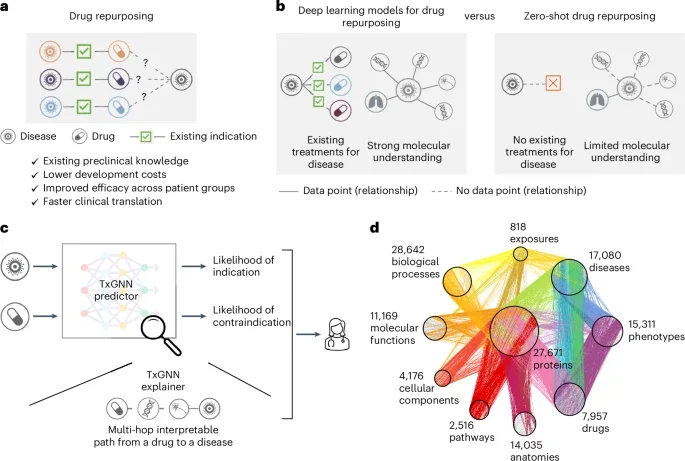Rare and undiagnosed diseases affect over 300 million people globally, posing an immense human and economic burden. These conditions, while individually rare, collectively represent a massive health challenge. Despite the urgency, only 5 to 7 percent of these diseases have an FDA-approved drug, leaving many patients without effective treatment options.
A groundbreaking artificial intelligence (AI) tool offers a new pathway to address this gap. Developed by researchers at Harvard Medical School and published in the journal, Nature Medicine, the AI model, called TxGNN, has demonstrated unprecedented potential to discover therapies for rare and neglected diseases.
By repurposing existing drugs, TxGNN identified treatment candidates for over 17,000 diseases, including those with no current treatments. This achievement marks a significant leap forward in drug discovery.
TxGNN is a graph-based AI model specifically designed for drug repurposing. Unlike traditional approaches that focus narrowly on diseases with existing therapies, this tool analyzes shared features across diseases to identify novel drug candidates. It uses a vast dataset, including genomic information, cell signaling data, and clinical records, to draw connections between diseases and potential treatments.

“With this tool, we aim to identify new therapies across the disease spectrum,” said Marinka Zitnik, lead researcher and assistant professor of biomedical informatics at Harvard Medical School. “For rare and neglected conditions, this model could help close a gap that creates serious health disparities.”
In its initial trials, TxGNN examined nearly 8,000 FDA-approved and experimental medicines, identifying potential uses for over 17,000 conditions. Its predictions also included insights into possible side effects and contraindications, offering a level of transparency that enhances physician confidence.
Repurposing existing drugs offers a faster and more cost-effective route to therapy development. Many drugs have effects beyond their original targets, some of which remain undiscovered during initial clinical trials. Over time, nearly 30 percent of FDA-approved drugs have acquired additional indications, with some gaining numerous new uses.
Related Stories
Traditionally, drug repurposing has relied on chance discoveries or off-label uses guided by clinician intuition. TxGNN aims to replace this serendipitous approach with a strategic, data-driven methodology. The model’s capacity to identify shared genomic underpinnings across diseases allows it to extrapolate from well-studied conditions to those that are poorly understood.
“We’ve tended to rely on luck and serendipity rather than on strategy, which limits drug discovery to diseases for which drugs already exist,” Zitnik explained. “Even for common diseases, new drugs could offer alternatives with fewer side effects or better efficacy for certain patients.”
TxGNN outperformed leading AI models for drug repurposing, demonstrating nearly 50 percent greater accuracy in identifying drug candidates and 35 percent better prediction of contraindications. This performance was validated using 1.2 million patient records and various experimental tasks.
For instance, the model successfully identified potential treatments for three rare conditions it had not encountered during training: a neurodevelopmental disorder, a connective-tissue disease, and a genetic condition affecting water balance.

What sets TxGNN apart is its “Explainer” feature, which provides detailed rationales for its predictions. This transparency aligns the model closer to human clinical reasoning, offering multi-hop medical knowledge paths that clinicians can review. “This capacity to reason and explain enhances trust in the model’s recommendations,” Zitnik noted.
Moreover, the tool’s predictions often aligned with existing off-label uses, further validating its reliability. For instance, in one task, TxGNN identified small molecules capable of targeting proteins involved in disease-causing pathways. These findings not only aligned with current medical knowledge but also highlighted the model’s potential to uncover novel therapeutic avenues.
The implications of TxGNN extend far beyond rare diseases. For conditions with existing treatments, the model could identify alternatives with fewer side effects or improved efficacy. By repurposing drugs with known safety profiles, TxGNN accelerates the pathway to clinical application, bypassing the lengthy and expensive process of developing new drugs from scratch.

The research team has made the tool freely available, encouraging clinician-scientists to explore its capabilities. Several rare disease foundations have already partnered with the team to identify potential treatments for conditions with limited or no therapeutic options.
While the therapies identified by TxGNN require further validation, the model’s unprecedented capacity for drug repurposing represents a transformative step in medicine. “This is precisely where we see the promise of AI in reducing the global disease burden,” Zitnik said. “Finding new uses for existing drugs is faster, more cost-effective, and has the potential to save countless lives.”
Note: Materials provided above by The Brighter Side of News. Content may be edited for style and length.
Like these kind of feel good stories? Get The Brighter Side of News’ newsletter.
The post Researchers use AI to help repurpose drugs to treat rare diseases appeared first on The Brighter Side of News.